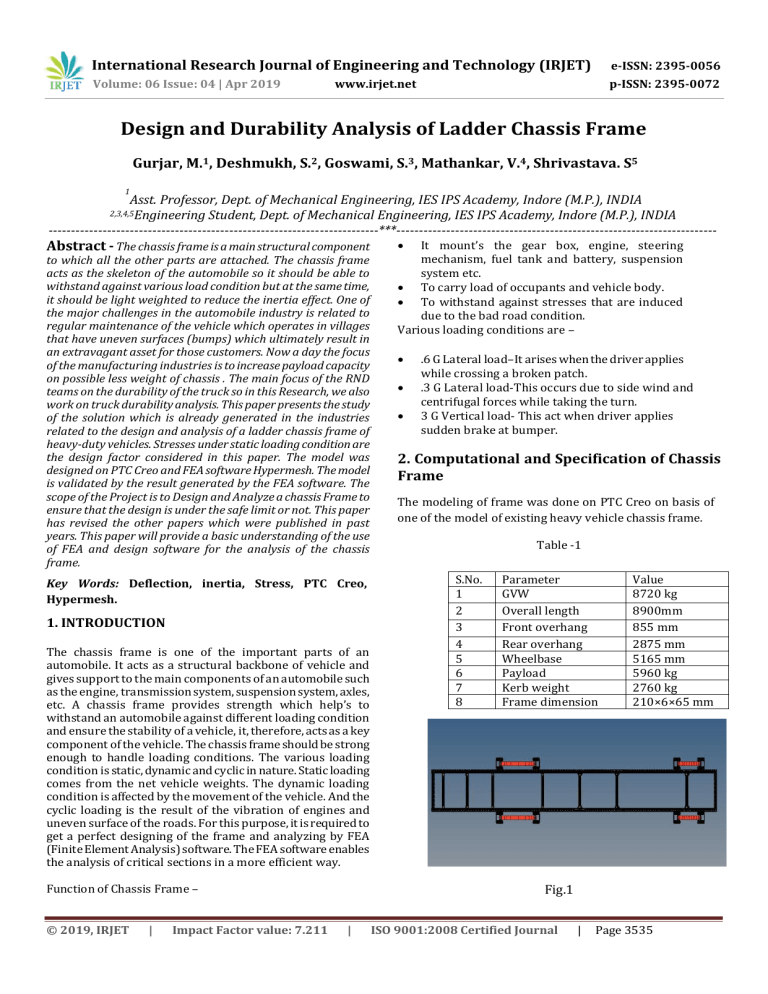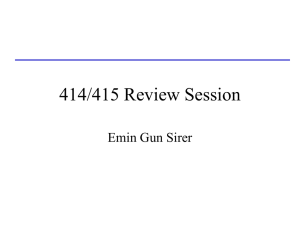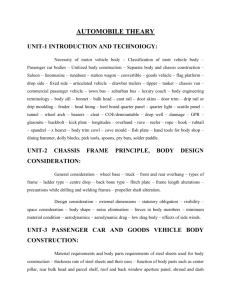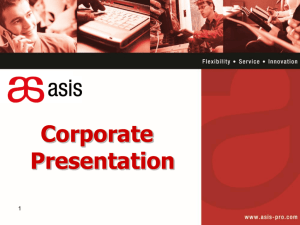IRJET-Design and Durability Analysis of Ladder Chassis Frame
advertisement

International Research Journal of Engineering and Technology (IRJET) e-ISSN: 2395-0056 Volume: 06 Issue: 04 | Apr 2019 p-ISSN: 2395-0072 www.irjet.net Design and Durability Analysis of Ladder Chassis Frame Gurjar, M.1, Deshmukh, S.2, Goswami, S.3, Mathankar, V.4, Shrivastava. S5 1 Asst. Professor, Dept. of Mechanical Engineering, IES IPS Academy, Indore (M.P.), INDIA Student, Dept. of Mechanical Engineering, IES IPS Academy, Indore (M.P.), INDIA -------------------------------------------------------------------------***----------------------------------------------------------------------2,3,4,5Engineering Abstract - The chassis frame is a main structural component to which all the other parts are attached. The chassis frame acts as the skeleton of the automobile so it should be able to withstand against various load condition but at the same time, it should be light weighted to reduce the inertia effect. One of the major challenges in the automobile industry is related to regular maintenance of the vehicle which operates in villages that have uneven surfaces (bumps) which ultimately result in an extravagant asset for those customers. Now a day the focus of the manufacturing industries is to increase payload capacity on possible less weight of chassis . The main focus of the RND teams on the durability of the truck so in this Research, we also work on truck durability analysis. This paper presents the study of the solution which is already generated in the industries related to the design and analysis of a ladder chassis frame of heavy-duty vehicles. Stresses under static loading condition are the design factor considered in this paper. The model was designed on PTC Creo and FEA software Hypermesh. The model is validated by the result generated by the FEA software. The scope of the Project is to Design and Analyze a chassis Frame to ensure that the design is under the safe limit or not. This paper has revised the other papers which were published in past years. This paper will provide a basic understanding of the use of FEA and design software for the analysis of the chassis frame. Key Words: Deflection, inertia, Stress, PTC Creo, Hypermesh. 1. INTRODUCTION The chassis frame is one of the important parts of an automobile. It acts as a structural backbone of vehicle and gives support to the main components of an automobile such as the engine, transmission system, suspension system, axles, etc. A chassis frame provides strength which help’s to withstand an automobile against different loading condition and ensure the stability of a vehicle, it, therefore, acts as a key component of the vehicle. The chassis frame should be strong enough to handle loading conditions. The various loading condition is static, dynamic and cyclic in nature. Static loading comes from the net vehicle weights. The dynamic loading condition is affected by the movement of the vehicle. And the cyclic loading is the result of the vibration of engines and uneven surface of the roads. For this purpose, it is required to get a perfect designing of the frame and analyzing by FEA (Finite Element Analysis) software. The FEA software enables the analysis of critical sections in a more efficient way. | Impact Factor value: 7.211 It mount’s the gear box, engine, steering mechanism, fuel tank and battery, suspension system etc. To carry load of occupants and vehicle body. To withstand against stresses that are induced due to the bad road condition. Various loading conditions are – .6 G Lateral load–It arises when the driver applies while crossing a broken patch. .3 G Lateral load-This occurs due to side wind and centrifugal forces while taking the turn. 3 G Vertical load- This act when driver applies sudden brake at bumper. 2. Computational and Specification of Chassis Frame The modeling of frame was done on PTC Creo on basis of one of the model of existing heavy vehicle chassis frame. Table -1 S.No. 1 2 3 4 5 6 7 8 Parameter GVW Overall length Front overhang Rear overhang Wheelbase Payload Kerb weight Frame dimension Value 8720 kg 8900mm 855 mm 2875 mm 5165 mm 5960 kg 2760 kg 210×6×65 mm Fig.1 Function of Chassis Frame – © 2019, IRJET | ISO 9001:2008 Certified Journal | Page 3535 International Research Journal of Engineering and Technology (IRJET) e-ISSN: 2395-0056 Volume: 06 Issue: 04 | Apr 2019 p-ISSN: 2395-0072 www.irjet.net 2.1 Thickness overview - 3 Material Used – In the chassis frame production technique, generally the material used for frame geometry is steel and its alloys. In this present study we have referred to the standard material which are generally used in industries .The material are as mentioned in the below table. Table -3 Material BSK 46 Domex 640 Fig.2 Density Young's (kg/m3) Modulus (GPa) 7850 200 7850 200 Poisson’s Ratio 0.3 0.3 Yield Strength (MPa) 460 620 2.2 Total mass – Below figure shows the total mass of chassis frame and various component attached to it. Fig.4 2.4 Element Quality CriteriaThe most important aspect of meshing is to check the quality parameters of elements. Table shows the standard quality criteria. Our meshing elements strictly follow these criteria. There are a lot of quality parameters which are necessary for ideal shape of an element, the most important are: warpage, aspect ratio, jacobian and tetcollapse. Element which fulfill these quality criteria is considered as good element and generate satisfactory result. Fig.3 Table -2 S.No. Component Mass(tones) 1 Engine+GB .711 Battery .05 Cab .75 Fuel tank .24 Spare wheel .12 Front axle .25 Rear axle .525 2 3 4 5 6 7 © 2019, IRJET Fig.5 | Impact Factor value: 7.211 | ISO 9001:2008 Certified Journal | Page 3536 International Research Journal of Engineering and Technology (IRJET) e-ISSN: 2395-0056 Volume: 06 Issue: 04 | Apr 2019 p-ISSN: 2395-0072 www.irjet.net 2.5 Static Analysis – It means that an analysis that is static takes the assumption that your system doesn’t depend on time. The algorithm the solver uses to solve such an analysis is also quite simple and can be resumed to a simple matrix computation. Static Analysis is used to find linear as well as non-linear deformations under static loading conditions Static analysis is used determine the failure in the chassis frame and minimize them taking into consideration the constraints of maximum shear stress, equivalent stress, and deflection of the chassis frame under maximum load condition. Under this condition, we applied following the loading condition and validate whether our design is safe or not. The structure can be simply assumed as a beam with uniformly distributed load due to cabin and body over its length and the point loads are considered at the transmission system, engine, fuel tank, and various heavy loaded accessories. Fig.6 (ii).Effect on chassis frame during normal braking (.6 G Lateral load) – In this case the load cases are as follow – In X direction = .6mg 2.6 Methodology In Y direction = 0 For Analysis, Our Model has been created on PTC Creo. After modeling, the model was converted into IGES format then It was imported into Hypermesh Optistruct. Thereafter the meshing of the model was done. We used 1-d meshing for bolt and leaf spring, 2-D meshing for Long and cross member and 3-D meshing on leaf Spring Holder. We took the element of size 10 mm and Mesh type mixed for 2-d meshing. In case of 3-D meshing we took mesh of size 5 mm After Applying material property, Constraint was given on the leaf springs and loading condition was applied for Static. In Z direction = mg (downward direction) 2.7 Initial Result(I).Effect on chassis frame when vehicle is taken a sharp turn at corner (3 G Lateral load) – Fig.7 When vehicle is taking sharp turn at corner we assume that following forces are acting on chassis frame. (iii). Effect on chassis frame when vehicle is gone through speed breaker or while speed braking (3 G Vertical load) In this condition it was found from previous study that g increases to 3 times. Let assume that vehicle is travelling in x direction and vehicle orientation is- In this case load cases are as follow – In X direction and Y direction = 0 In Z direction = 3mg (downward direction) In X direction = 0 In Y direction = 0.3mg In Z direction = mg (downward direction) Fig. 8 © 2019, IRJET | Impact Factor value: 7.211 | ISO 9001:2008 Certified Journal | Page 3537 International Research Journal of Engineering and Technology (IRJET) e-ISSN: 2395-0056 Volume: 06 Issue: 04 | Apr 2019 p-ISSN: 2395-0072 www.irjet.net Initial Result Conclusion – 1. Model passes in normal braking load case with 1.327 FOS. 2. Model passes in Cornering load c a s e with 1.41 FOS. 3. Model fails in speed breaker or while speed braking with .460 FOS. We observed that in 1 and 2 load cases our model was already safe. Now the iteration has been done to increase the FOS in case 3. Fig.11 3. Design ModificationWe observed that our model was failed at Bracket. So, we made changes in bracket shape. Fig.9 Fig.12 After iteration the FOS increased to 1.06 in Speed breaking load case. Again we removed some material from brackets. Fig.13 Fig. 10 It shows that our model is safe. 4. Design Optimization – To optimize our result we removed some material from brackets © 2019, IRJET | Impact Factor value: 7.211 | ISO 9001:2008 Certified Journal | Page 3538 International Research Journal of Engineering and Technology (IRJET) e-ISSN: 2395-0056 Volume: 06 Issue: 04 | Apr 2019 p-ISSN: 2395-0072 www.irjet.net c. Results after Iterations in speed braking load condition. Table-5 5. CONCLUSION In this type of linear analysis we performed durability analysis. Our first non optimized design failed in 3 G vertical loading at a cross member holding bracket after the modification we passed our model with more than 1 FOS, and there is a probability of optimization, after performing some iteration we got our optimized bracket design and we got this optimized design as near to real optimized design. Fig. 14 The final optimize shape of bracket is ACKNOWLEDGEMENT We wish to express our sincere thanks to Sumit Sharma Sir, Anil Lashkari Sir, IICAE INDORE and all mechanical faculties for their help and guidance given by them time to time. REFERENCES [1] [2] Fig. 15 It is expected to achieve a better performance of chassis frame and the main focuses of the analysis are listed below: a. The software results were used to validate a finite element model and the updated model shall represent the real structure of the chassis. b. Before iteration result Table-4 [3] [4] Ashutosh Dubey and Vivek Dwivedi, 2003. Vehicle Chassis Analysis: Load Cases and Boundary Conditions for Stress Analysis. Akash Singh Patel, Jaideep Chitransh. Design and Analysis of Tata2518 Truck Chassis Frame with various cross sections using CAE Tool.IJESRT Sep 2016; 2277-9655. Monika Agrawal .Finite Element Analysis of Truck Chassis Frame. IRJET June 2015 Volume: 02 Issue: 03; 2395-0056. Bhawnick P.Malhotra D.Agrawal P.Ravi K. Design and Analysis of a Pickup Truck Chassis.IJSIET May 2017 Volume: 01;978-81- 904760-9-6. [5] B Ramya, Sridhar Reddy, Dr. C. Udaya Kiran Design and Structural of chassis. IJEDR 2014 Volume: 02 Issue 4:2321-9939. [6] S. N. Vijayan, S Sendhilkumar. K. M Kiran Babu, Design and analysis of automotive chassis considering Cross Section and material, International Journal of Current Research vol.7, Issue, 05, pp.15697-15701, May, 2015 [7] Vijay kumar V Patel, Prof. R. I. Patel “Structural Analysis © 2019, IRJET | Impact Factor value: 7.211 | ISO 9001:2008 Certified Journal | Page 3539 International Research Journal of Engineering and Technology (IRJET) e-ISSN: 2395-0056 Volume: 06 Issue: 04 | Apr 2019 p-ISSN: 2395-0072 www.irjet.net of Automotive Chassis Frame and Design Modification for Weight Reduction” ISSN: 2278- 0181, International Journal of Engineering Research &Technology (IJERT) Vol. 1 Issue 3, pp.1-6, May-2012. BIOGRAPHIES Mr. Mayank Gurjar Asst. Professor IES IPS Academy Indore Shubham Deshmukh B.E. Graduate IES IPS Academy Indore Siddharth Goswami B.E. Graduate IES IPS Academy Indore Vikas Mathankar B.E. Graduate IES IPS Academy Indore Siddhant Shrivastav B.E. Graduate IES IPS Academy Indore © 2019, IRJET | Impact Factor value: 7.211 | ISO 9001:2008 Certified Journal | Page 3540




